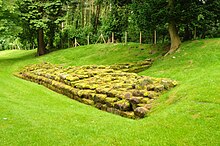Isurium Brigantum

IsuriumorIsurium of theBrigantes(Latin:Isurium Brigantum) was aRomanfortandtownin theprovinceofBritanniaat the site of present-dayAldboroughinNorth Yorkshire,England,in theUnited Kingdom.[1]Its remains—theAldborough Roman Site—are in the care ofEnglish Heritage.
TheRoman roadthrough the town formed a leg of bothDere Street—connectingEboracum(York) to theAntonine Wall—and the Roman equivalent ofWatling Street,which here connected Eboracum withLuguvalium(Carlisle). The modern village retains part of the Roman street plan and the church stands on the site of the forum.
History
[edit]
Isurium Brigantum, one of the northernmost urban centres of the Roman Empire[2]was probably founded in the late first century or early second century. The Romancivitaswas the administrative centre of theBrigantestribe, the largest and most northerly tribe in Roman Britain.[3]Roman towns such as Exeter, Leicester, Chichester and Canterbury had the same status asIsurium.[4]
Tacitusrecorded thatIsuerwas the seat ofVenutius,king of the Brigantes who was usurped from power by his wife,Cartismanduaand her lover Volucatus at the beginning of the first century. Cartismandua welcomed the Romans who perceived little threat from the Brigantes and the Roman army focused its occupation to the south of Brigantium.[5]When Venutius and his followers began to attack Brigantian centres towards the end of the first century, the Roman army pushed further north. Tacitus reports the final subjugation of the Brigantes came about byJulius Agricolain 79 AD. who then constructed Isurium.[6]

Its name is believed to be derived from the Latin name of the riverIseurnow theRiver Ure.It is likely there was a Brigantian settlement atIsuriumbefore the Roman invasion. There are many prehistoric sites along theA1corridor which partially follows the route ofWatlingandDere Streets.There are three ancient standing stones in Boroughbridge known as theDevil's Arrowsa mile distant from the site.[7]
There is in fact no archaeological evidence to suggest that there was a Brigantian settlement called Iseur: the most likely Iron Age settlement isStanwickfurther north nearRichmondwhere Cartimandua had her base. Isurium probably became a civilian settlement between theRoecliffefort (see below) and the River Ure during the last part of the first century. The Civitas Capital was probably established in about 160 AD.
It was supposed that Isurium was the site of a 1st-centuryRoman fortwhere Watling and Dere Streets crossed theRiver Ure.Excavations in 1993 located two forts at Roecliffe nearBoroughbridgeand 1st-century finds at Aldborough most likely come from a related civilian site. Isurium Brigantum had substantial buildings from an early period; probably by the early 2nd century. Bank and ditch defences were erected later. Stone walls and four gates were added in the mid-3rd century. The visible remains are a small fraction of the Roman town. Isurium flourished for the next hundred years, with the building of elaborate private homes with fine decorativemosaicfloors. In the middle of the 4th century,bastionswere added to its defences and general unrest across theEmpireseems to have affected the town's prosperity.

There is little evidence of occupation after theend of Roman rule in Britainand by the 7th century theAnglo-Saxonshad taken over the area.
Archaeology
[edit]The 16th-century antiquaryJohn Lelandnoted,"There be now large feeldes, fruteful of corn, in the very places where the howsing of the town was; and in these feeldes yereley be founde in ploughing many coynes of sylver and brasse of the Romaine stampe—Ther also have been found sepulchres, aqaue ductus tessalata paviamenta &.c."[8]Two centuries after Leland,Daniel Defoewrote"Not so much ruins, especially not above ground".[9]
In 2011, geomagnetic scanning revealed the existence of anamphitheatre,emphasising Isurium's importance as a major Roman town.[10]
The site came to prominence during excavations taking place in 2004. A young archaeologist, Daniel Ebdon, was using a metal detector for the first time and uncovered a Roman coin. This, along with others of its kind, can be found in The Yorkshire Museum, York.
Aldborough Roman Site
[edit]Aldborough Roman Site is in the care ofEnglish Heritageand consists of a stretch of the massive town wall with its defensive towers and two in-situ mosaic pavements, once part of a Roman townhouse. Archaeological finds from the site are on display in the museum providing an insight into the lives of Roman civilians in its most northern capital.
Aldborough Roman town has been designated ascheduled monumentunder theAncient Monuments and Archaeological Areas Act 1979.[11]
The Aldborough Roman Town Project, led byRose FerrabyandMartin Milletthas been investigating the site since 2016.[12]In 2019 Ferraby and sound artist Rob St John created a site specific audio trail exploring the Roman town.[13]
References
[edit]- ^Esmonde Cleary, A., R. Talbert, S. Gillies, J. Åhlfeldt, R. Warner, J. Becker, T. Elliott."Places: 89209 (Isurium)".Pleiades.Retrieved22 July2014.
{{cite web}}:CS1 maint: multiple names: authors list (link) - ^Dobinson, C. (1995 (revised reprint 2012))Aldborough Roman Town.English Heritage. p.1
- ^"The BrigantesRoman-Britain.co.uk. 24 October 2007.
- ^(Dobinson 1995, p.3)
- ^Fletcher, J. S. (1901) "A Picturesque History of Yorkshire: Being an Account of the History, Topography, and Antiquities of the Cities, Towns and Villages of the County of York, Founded on Personal Observations Made During Many Journeys Through the Three Ridings, Volume 3"
- ^Tacitus: "Agricola" c.98 AD
- ^new.archaeologyuk.org/.../583_Yorkshire%20Henges%20Booklet%20(general).pdf
- ^Toulmin Smith, L (ed.) — (1964) The Itinerary of John Leland: In Or about the Years 1535-1543, Parts I to [XI]
- ^Defoe, D.A Tour Thro' The Whole Island of Great Britain, Divided into Circuits or Journies (1724–1727)
- ^Wainwright, Martin (17 August 2011)."Archaeologist digs into grandad's tale to uncover lost Yorkshire amphitheatre".guardian.co.uk.Retrieved19 August2011.
- ^Historic England."Aldborough Roman town (Grade Scheduled Monument) (1003133)".National Heritage List for England.Retrieved4 May2022.
- ^"Aldborough Roman Town Project — Faculty of Classics".classics.cam.ac.uk.10 May 2019.Retrieved14 January2021.
- ^"Soundmarks: Beginnings | Caught by the River | Caught by the River".caughtbytheriver.net.Retrieved14 January2021.
External links
[edit]- History of North Yorkshire
- Archaeological sites in North Yorkshire
- Roman towns and cities in England
- Tourist attractions in North Yorkshire
- Museums in North Yorkshire
- Museums of ancient Rome in the United Kingdom
- Archaeological museums in England
- Boroughbridge
- English Heritage sites in North Yorkshire
- Roman sites in North Yorkshire
- Scheduled monuments in North Yorkshire

